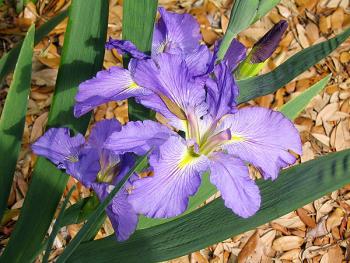
Louisiana iris
--LSU AgCenter/Dan Gill
Get It Growing: Time to divide Louisiana irises
It always surprises me that some Louisiana gardeners are not familiar with our native Louisiana irises. Some of the most beautiful irises we can grow in our gardens are the hybrids of several species that grow right here in Louisiana. Hopefully, you have these wonderful plants growing in your garden. If not, you really should consider planting some.
The species called Louisiana irises are Iris giganticaerulea, I. fulva, I. brevicaulis, I. nelsonii and I. hexagona. All five species occur only in Louisiana. They are closely related and will interbreed with one another. Crosses between the species have produced an amazing array of outstandingly beautiful hybrids that are also called Louisiana irises. Most of the Louisiana irises you find for sale will be hybrids of these species, although the individual species are also beautiful and worthy of use.
For gardeners who are already growing these wonderful plants, Louisiana irises can be divided and transplanted anytime from August through early October. Unlike most plants, Louisiana irises are at their most dormant stage in late summer making now the ideal time to divide them. You might have noticed many brown or yellow leaves on your plants now. Even if you decide you don’t need to divide them this year, it’s a good idea to get in and clean out the unattractive foliage before the new growth starts in earnest. This will make the planting more attractive.
Each year Louisiana irises grow and spread, creating more rhizomes and shoots. Eventually, the plants may become crowded, which can lead to lower vigor and poor flowering. This generally occurs two to three years after the bed is planted, depending on how close together the rhizomes were planted to begin with and how much room they have to spread. Clumps also may grow beyond their allotted space, and dividing will help keep the clump the size you want and prevent the irises from taking over areas where they were not intended to grow.
The first step is to use a shovel or garden fork to lift the plants from the bed. Try to get as much of their root systems as possible, and do not damage the fans of new growth at the ends of the rhizomes. Put them aside in a shady area and hose them down to keep them from drying out.
Once the bed is empty, take the opportunity to improve the soil bed before you replant the irises. Spread a 2-inch layer of compost or other organic matter over the soil, sprinkle a light application of a general-purpose fertilizer over the area, and thoroughly incorporate everything into the bed. While you are doing this, make sure the roots of the irises you have dug out of the bed do not dry out.
To divide your irises, look over the clumps carefully. You will see that young rhizomes branch off from the older rhizomes. The younger rhizomes have a fan of green leaves at their tips with roots growing out from the rhizome at the base of the leaves. Break or cut off the young rhizomes at the point where they branch off from the old rhizome. Discard the old rhizome and replant the young rhizomes.
Plant the rhizomes horizontally with the fan of foliage facing the direction you want the plant to grow, and carefully cover all of the roots. Space the rhizomes about a foot apart. The top of the rhizome should be just below or barely show above the soil surface. Mulch the bed about 2 inches deep, and water it thoroughly. If you have any rhizomes left over, pot them up to share with friends.
If the weather should become dry this fall, winter or spring, it’s a good idea to water the iris bed once or twice a week. An application of general-purpose fertilizer in February, following label directions, will keep the plants growing vigorously into the blooming season.
Louisiana irises growing in containers in aquatic gardens may also need to be divided and repotted, and this is a good time to do that as well. Remove the plants from the pot and follow the procedure above to divide them. Use pond fertilizer tablets according to label directions to fertilize containerized Louisiana irises in aquatic gardens.
This is also a good time to purchase and plant new Louisiana irises into sunny beds or aquatic gardens. Some local nurseries may have them for sale, so it’s worth checking. If you don’t see them available, don’t despair. Blooming plants are generally available in the spring and do just fine planted then. Or check out possible mail order sources online by typing Louisiana iris into an Internet search engine.
A few other perennial plants grown in Louisiana gardens should be divided and transplanted over the next few weeks. Like the Louisiana irises, they tend to be dormant now and will begin to grow actively sometime in October as the weather cools down. Feel free to divide and transplant Easter lilies, acanthus and calla lilies. If you’d like to divide or transplant red spider lilies (Lycoris radiata, also called hurricane lilies or naked ladies), you may do so as soon as they finish blooming.
- Log in to post comments
